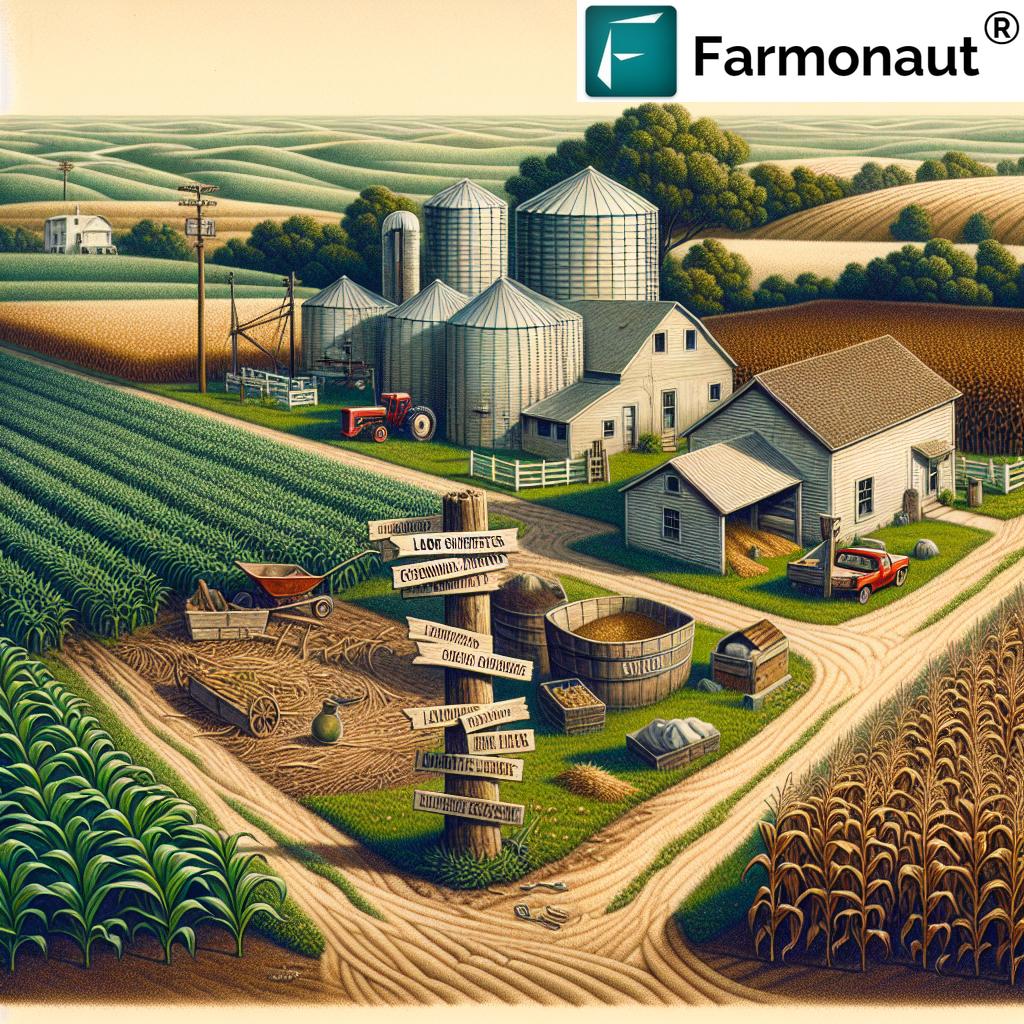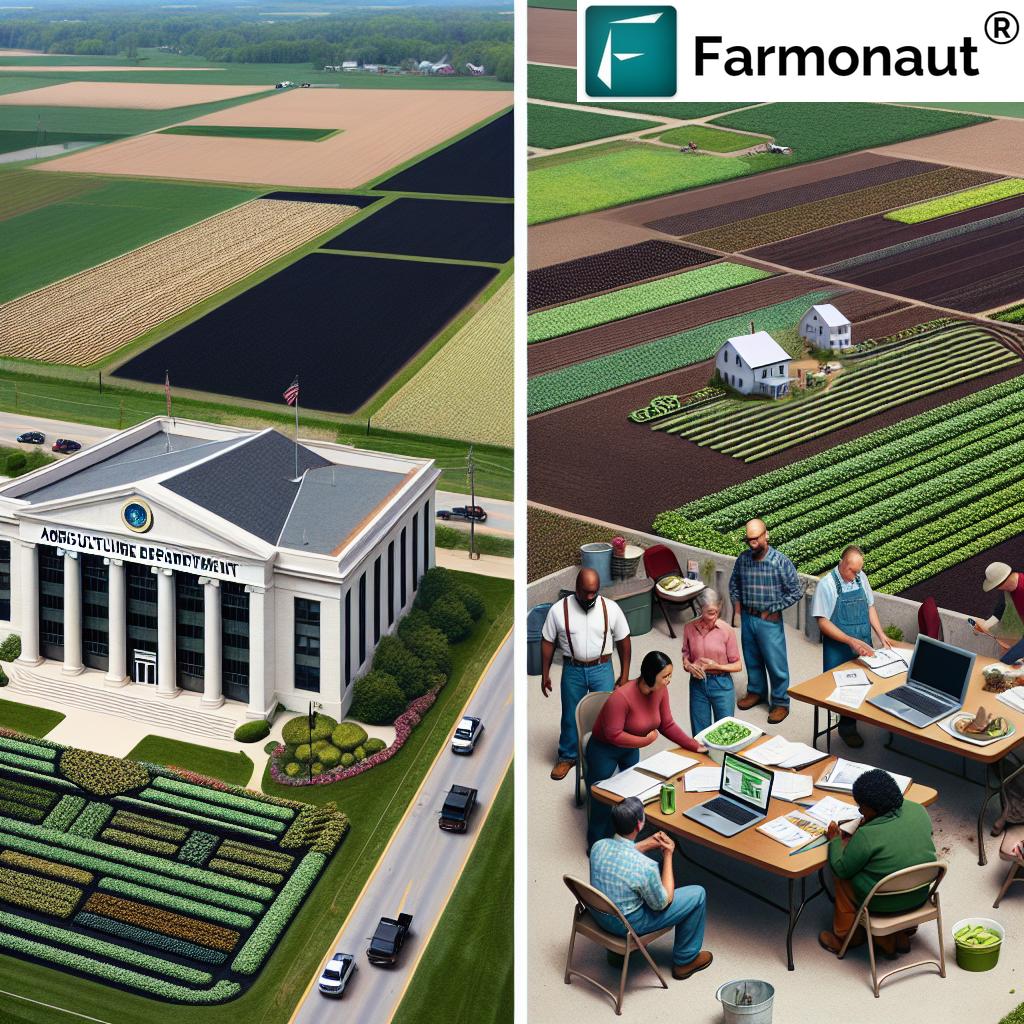Are Farmers in Trouble? 7 Urgent Challenges Facing Nebraska
Meta Description: Farmers in Nebraska face urgent challenges threatening their livelihoods: economic pressures, labor shortages, climate change impacts, policy uncertainties, supply chain disruptions, and more. Explore key issues affecting global food security, and how technology and innovation can help.
Table of Contents
- Introduction: The Complex Landscape of Nebraska Farming
- 1. Economic Pressures on Farmers
- 2. Agricultural Labor Shortages & Workforce Challenges
- 3. Climate Change Impact on Crops
- 4. Technological Barriers in Agriculture
- 5. Agricultural Supply Chain Disruptions
- 6. Policy Uncertainties in Agriculture
- 7. Environmental Challenges to Farming: A Global Perspective
- Comparative Challenges Impact Table
- How Farmonaut Addresses Key Agricultural Challenges
- Frequently Asked Questions (FAQ)
- Conclusion: Navigating the Future of Farming
“Over 70% of Nebraska farmers report economic pressures as their top challenge, impacting food security and sustainability.”
Introduction: The Complex Landscape of Nebraska Farming
Farming has always been the backbone of Nebraska and much of the United States. With sweeping Great Plains fields, innovative agricultural practices, and a long tradition of resilience, Nebraska’s farmers feed not only America but also a hungry world. However, the challenges facing farmers today are greater and more urgent than ever before, threatening not just livelihoods in Nebraska but also the stability of global food systems.
Farmers across Nebraska and worldwide are confronting a multitude of issues: economic pressures brought on by volatile markets and declining profits, labor shortages due to demographic shifts and policy changes, rapidly evolving environmental challenges like climate change, and sweeping technological barriers that hinder progress for smaller farms. These are further complicated by supply chain disruptions and ongoing policy uncertainties, all while the global population rises and expectations for sustainable food production increase.
In this comprehensive blog post, we’ll examine the seven urgent challenges facing Nebraska farmers, shed light on key food security issues, integrate local data, and highlight innovative solutions—especially how we at Farmonaut use satellite-based technologies and data-driven tools to empower farmers to overcome these obstacles. Are Nebraska farmers in trouble? Let’s dig into the data, the impacts, and the road ahead.
1. Economic Pressures on Farmers
Economic Pressures are Increasing for Nebraska Farmers
One of the greatest challenges facing farmers in Nebraska is the mounting economic pressure caused by persistent shifts in market conditions, volatile prices, and changed consumer trends. This is especially true in the wheat sector, which has suffered significant declines in recent years. According to government data and recent reports, Nebraska’s wheat acreage has dropped from 2.2 million to under a million acres in just two decades.
Why is this happening?
- Low commodity prices: Persistently low prices for wheat continue to depress profits.
- Increased competition from profitable crops: More farmers are planting corn and soybeans as they offer better margins, leading to reductions in wheat acreage.
- Climate and drought: Droughts and climate variability have caused more field abandonment and declining yields, impacting livelihoods.
- Global oversupply: Wheat markets are further stressed by oversupply and policy-driven market entry of international competitors.
- Cost of inputs: Rising costs for seed, fertilizers, and energy further squeeze already thin profit margins.
Even with diversification efforts (such as rotating between wheat, corn, and cattle), most farmers in Nebraska report profits remain elusive. Many are compelled to shift acreage towards more profitable options, but even then, the future is far from secure. These economic pressures on farmers exacerbate financial uncertainties, make it difficult to plan for the long term, and undermine the stability of not only Nebraska’s food systems but also those worldwide.
Key takeaways:
- Nebraska’s wheat acreage has declined by over 50% in the past 20 years.
- Economic uncertainty causes an increase in farm abandonment and decreased investment in modern technology.
- Struggles in Nebraska mirror those in Kansas and Oklahoma, creating a “wheat belt” crisis.
For farm owners, economic survival often now means making tough choices—between crops, technologies, or even whether to keep farming at all.
“Labor shortages in agriculture have risen by 30% globally, intensifying the need for innovative solutions in farming.”
2. Agricultural Labor Shortages & Workforce Challenges
Agricultural Labor Shortages Threatening Food Security
Nebraska, like the rest of the United States, faces a persistent agricultural labor shortage. This is not only a local issue but also mirrors a global trend that threatens food security and production capacity.
What’s causing the labor shortage?
- Aging Workforce: Farmers across Nebraska are aging, with fewer young people choosing to work in the industry.
- Rural Depopulation: As rural communities shrink, the available labor pool for local farms continues to decline.
- Competition from Other Sectors: Industrial, construction, and service sectors lure away potential agricultural workers due to higher pay or less strenuous working conditions.
- Legal Authorization Challenges: Approximately 40% of U.S. farmworkers lack legal authorization, adding to uncertainty. Ongoing policy shifts and an unclear regulatory environment make it increasingly difficult for farm businesses to confidently employ workers, especially those who are undocumented or have temporary visas.
Policy uncertainty is further heightened by recent enforcement changes. Farmers are “in limbo” regarding legalization pathways or future crackdowns, which complicates compliance and hiring processes. The broader challenge is stark: labor shortages in agriculture have risen by 30% globally, emphasizing the urgent need for new approaches—automation, worker retention strategies, and policy reform.
Consequences for Nebraska farmers include:
- Crops potentially going unharvested, leading to lost revenue and food waste.
- Delayed planting or missed market opportunities.
- An increased reliance on seasonal or temporary labor, often at higher costs and under less certain conditions.
Explore Farmonaut’s Large-Scale Farm Management Solutions for real-time data, satellite crop monitoring, and digital fleet resource tools designed to streamline operations for Nebraska farms of any size.
3. Climate Change Impact on Crops
Nebraska’s Climate: A Looming Threat to Food Production
Climate change is perhaps the most formidable of all environmental challenges to farming in Nebraska and the world. Rising temperatures, shifting precipitation patterns, and an increased frequency of extreme weather events profoundly disrupt crop production systems.
A recent study estimates every 1°C rise in global temperature may reduce food production capacity by 120 calories per person per day. Nebraska’s position in the Great Plains makes it especially vulnerable to drought, unpredictable rainfall, and unprecedented heatwaves.
What crops are most at risk?
- Corn, soybeans, and wheat—Nebraska’s core crops—are projected to experience substantial yield declines by 2100 under moderate emissions scenarios.
- Even with adaptation efforts such as new hybrids, irrigation, and shifts to more resilient crops, the challenge remains vast.
- Soil health suffers due to erosion, nutrient depletion, and loss of organic carbon—exacerbating productivity declines and input costs.
Consequences of climate change impact on crops:
- Increased risk of crop abandonment, lower yields, and crop loss.
- Greater reliance on insurance, subsidy, and loan mechanisms as weather risks become unmanageable.
- Expansion of pests and diseases, adding further stress and cost layers.
Farmonaut’s carbon footprint tracking (learn more about this feature) empowers farmers and agri-businesses to monitor their environmental impact in real time, take corrective action, and work towards compliance and long-term sustainability.
4. Technological Barriers in Agriculture
Technological Barriers: A Roadblock for Nebraska Farmers
We live in a digital age where agricultural technology offers unprecedented opportunities to boost yield, efficiency, and sustainability. But for many Nebraska farmers, significant technological barriers persist—often due to costs, skills gap, and limited access.
What are the barriers?
- High Upfront Costs: Modern innovations like GPS-guided tractors, drones, and IoT sensors demand capital investment many small- or medium-sized farms can’t afford.
- Limited Access for Small Farms: Precision agriculture often remains out of reach for the majority, reinforcing inequalities.
- Skill Gap: Farmers may lack the training to fully utilize high-tech tools, leading to under-implementation.
- Data Security Concerns: As more farm management moves online, the risks of data breaches, privacy exposure, and cyber threats increase for all.
- Fragmented Technology Ecosystem: Disjointed platforms for monitoring, analysis, and reporting add complexity, rather than streamlining farm management.
Technological barriers in agriculture ultimately slow down the adoption of solutions that could counteract many of Nebraska’s other problems, from climate adaptation to labor automation.
Farmonaut offers a mobile-first, affordable approach by delivering satellite-powered crop monitoring via web and smartphone apps, reducing the cost and complexity of precision farming for all scale operators.
If your agribusiness needs to automate fleet management and resource tracking, read how Farmonaut’s Fleet Management features can help you efficiently allocate vehicles and reduce operational costs.
5. Agricultural Supply Chain Disruptions
Disruptions Hit Every Link in the Chain
The agricultural supply chain is a sophisticated web of equipment suppliers, chemical providers, processors, transporters, retailers, and ultimately, consumers. Its disruption wreaks havoc on Nebraska farmers’ ability to access vital inputs and deliver products to market efficiently and profitably.
Key supply chain challenges include:
- Transportation Costs: Fuel price volatility and logistical bottlenecks make moving crops more expensive and unpredictable.
- Equipment Delays: Global shortages of key agricultural hardware delay planting, maintenance, and harvests.
- Reliance on Imports: Many fertilizers and crop protections come from overseas, exposing Nebraska farmers to international disruptions.
- Distribution Gaps: When supply chains are stretched—due to weather, policy, or geopolitical events—food security gets compromised.
- Traceability Pressures: Modern consumers demand greater transparency on food origin, safety, and handling at every supply chain stage.
To strengthen food security and minimize risk, Farmonaut’s Traceability Solutions use blockchain so every stage of the product’s journey—from Nebraska’s fields to grocery shelves—is recorded, verified, and accessible for all stakeholders.
6. Policy Uncertainties in Agriculture
Policy Uncertainties: Legal Authorization, Immigration, and More
Nebraska’s farming community has always been shaped by federal and local agricultural policy. But in recent years, rapid shifts, regulatory changes, and legal uncertainties have brought confusion and risk.
Main areas of policy uncertainty for Nebraska include:
- Immigration Enforcement: As noted, approximately 40% of U.S. farm labor lacks full legal authorization—a figure echoed in Nebraska. Recent federal enforcement changes have created “gray zones” in hiring, job security, and compliance for agricultural operations.
- Subsidies & Support Programs: Shifts in available aid, insurance, or technical support can profoundly affect farm finances.
- Trade Policy: Tariffs or policy changes at the national level alter competitive positions worldwide, increasing volatility and unpredictability.
- Environmental Regulation: Ongoing debates on water use, crop insurance, runoff, and emissions standards generate long-term uncertainty for farm planning and operation.
These policy uncertainties in agriculture complicate farm business models, raise legal risks, and dampen willingness to invest in new crops, experiments, or technology. Reliable satellite verification tools for crop loan and insurance can help Nebraska farmers access needed capital while reducing administrative headaches and fraud risks.
7. Environmental Challenges to Farming: A Global Perspective
Understanding the Global Context of Agricultural Challenges
While this article is Nebraska-centric, it’s impossible to separate local issues from broader global food security issues and environmental challenges to farming. Farmers in Africa, for instance, face their own set of agricultural challenges that echo—and sometimes intensify—those confronting the Great Plains.
Key global environmental challenges include:
- Soil Acidity: In Kenya, 63% of arable land is acidic, but only 1–8% of farmers apply lime to remedy this. Acidic soils hinder crop growth, reduce fertilizer effectiveness, and lower yields.
- Limited Access to Irrigation: Over 90% of Africa’s agriculture is rain-fed, making it extremely vulnerable to climate variability and droughts—challenges Nebraska increasingly shares thanks to more erratic weather.
- Post-Harvest Losses: Lack of storage and processing means nearly a third of food produced is lost before it gets to consumers.
- High Input Costs & Low Access to Modern Technology: These global constraints mirror the cost barriers anyone farming wheat, corn, or soybeans in Nebraska understands.
- Pest Infestation and Disease Spread: Climate changes create ideal conditions for new pests and diseases to thrive, increasing losses and costs.
- Policy and Institutional Barriers: Inadequate support structures and shifting policies, from financial support to technical outreach, further complicate sustainable production systems both in the US and abroad.
By putting Nebraska’s challenges in a global context, we better appreciate the need for data-driven agricultural management, investment in new technologies, and policy reforms that build resilience—locally and worldwide.
Comparative Challenges Impact Table: How Nebraska Farmers Are Affected
| Challenge | Estimated Prevalence (% of Nebraska farms affected) |
Est. Economic Impact ($USD millions) | Environmental Impact | Duration of Challenge | Example Technological or Policy Solutions |
|---|---|---|---|---|---|
| Economic Pressures | 70% | $250M–$400M annually | Medium | Long term | Precision farming apps, crop diversification, market stabilization programs |
| Labor Shortages | 60% | $140M–$180M in lost production | Low | Medium to long term | Labor automation, policy reform, digital farm management solutions |
| Climate Change Impact | 85% | $280M+ (by 2050, projected) | High | Long term | Carbon monitoring tools, crop insurance, climate-resilient seed technology |
| Technological Barriers | 50% | $100M–$120M (reduced yield potential) | Medium | Medium term | Affordable satellite solutions, digital literacy initiatives, scalable APIs |
| Supply Chain Disruptions | 55% | $80M–$100M in delayed/undelivered crops | Medium | Short to medium term | Blockchain traceability, resilient logistics planning, localized supply programs |
| Policy Uncertainties | 65% | $50M–$60M in hedged losses | Low | Short to medium term | Policy advocacy, satellite-based compliance tracking, financial support |
| Environmental Challenges (Global) | Varies (Africa: soil acidity >60%, limited irrigation >90%) | $500M+ (continent-wide losses) | High | Long term | Soil health analytics, lime/fertilizer advisory, digital weather platforms |
How Farmonaut Addresses Key Agricultural Challenges
At Farmonaut, we understand the complexity of the agricultural landscape — especially for Nebraska’s farmers wrestling with economic, environmental, and technological obstacles.
Our mission is simple yet transformative: democratize access to cutting-edge technology and actionable data-driven insights so that every farmer—from the Great Plains to Africa—can manage their land more profitably, sustainably, and securely.
What sets Farmonaut apart?
- Satellite-Based Crop Monitoring: Real-time, affordable NDVI, soil moisture, and crop health data accessible via web and smartphone—meaning even small and medium-sized farms in Nebraska can use precision agriculture without prohibitive upfront costs.
- Personalized AI Advisory: The Jeevn AI System gives tailored crop management advice, leveraging big data and weather simulations to recommend farming best practices specific to each field.
- Blockchain Traceability: Our platform tracks product movement through every stage of the agricultural supply chain, enhancing trust and ensuring transparency for Nebraska-grown food and beyond.
- Resource and Fleet Management: Digital tools allow for smarter vehicle and resource allocation, reducing costs and ensuring timely farm operations.
- Carbon Footprinting: Monitor, report, and improve your farm’s sustainability performance with real-time emissions data and compliance reporting. Explore carbon footprinting in detail!
- Financing Support: Satellite-based crop verification means easier access to loans and reduced insurance fraud for farm operators. — learn about crop loan and insurance support.
- API for Developers & Businesses: Flexible, scalable APIs and developer docs make it easy for agritech companies and research institutions to integrate satellite and weather data.
Farmonaut’s strengths:
- Precision agriculture for every scale and budget
- Immediate resource allocation and cost savings
- Instant compliance reports for loans, insurance, and sustainability
Farmonaut provides a modular subscription model — choose the specific features your farm or agribusiness needs, and scale them as you grow. Our solutions are mobile-responsive, ensuring efficient usability whether in the office or in the field. Check our latest farm management platform to see it in action!
Frequently Asked Questions (FAQ)
What are the biggest challenges facing farmers in Nebraska today?
Nebraska farmers face urgent issues including economic pressures from volatile market conditions, agricultural labor shortages, climate change impact on crops, technological barriers, policy uncertainties, and supply chain disruptions. These factors contribute to a decline in wheat production, threaten livelihoods, and undermine global food security.
How is climate change impacting crop yields in Nebraska?
Rising temperatures, more frequent droughts, and unpredictable weather events reduce yields of key crops like corn, soybeans, and wheat. Extreme weather can also cause field abandonment and exacerbate input costs, posing a significant threat to food production systems.
Why are labor shortages so severe in Nebraska’s agricultural sector?
Aging farmers, rural depopulation, policy shifts affecting worker authorization, and competition from other sectors all combine to create a persistent agricultural labor shortage. This has led to delayed harvests, higher costs, and lost production.
What is Farmonaut and how can it help my farm?
Farmonaut is an agricultural technology provider offering satellite-powered real-time crop monitoring, AI advisory systems, blockchain traceability, and resource management tools. These solutions equip farmers of all scales with actionable insights to increase yields, reduce costs, and manage risks — all via affordable mobile/web apps or APIs.
Is Farmonaut affordable for family farms or only for large agribusinesses?
Farmonaut’s platform is designed for scalability and affordability. Small, medium, and large farms can all access precision farming features tailored to their needs, with flexible subscription options. Check the latest mobile-responsive features or subscription packages via our web or mobile app.
Does Farmonaut maintain security and privacy of my farm’s data?
Absolutely. Security and privacy are cornerstones of our service. We utilize encryption, secure data storage, and transparent protocols so farmers can trust that their data is protected and used only for improving agricultural operations—not for unauthorized commercial purposes.
Where can I learn more or try these services?
You can download our Android app here, iOS app here, or visit the web app here. For developer or enterprise integration, check our API platform and developer documentation.
Conclusion: Navigating the Future of Farming in Nebraska
The challenges facing Nebraska farmers—from mounting economic pressures to climate change, labor shortages, supply chain disruptions, policy uncertainty, and global market shifts—are complex and interconnected. Addressing these requires collective action from stakeholders, policy-makers, technology providers, and, above all, the farmers themselves.
Farmers’ role in ensuring global food security and environmental sustainability remains irreplaceable. As the decline in wheat production and field abandonment make clear, this is a pivotal moment for Nebraska’s agricultural sector.
But we have reasons for optimism. With innovative technology, data-driven management, and strategic adaptation, Nebraska’s farming community can:
- Weather the financial storm with better market and risk insights
- Streamline operations to combat labor shortages and reduce overhead
- Implement climate-smart strategies using real-time data and AI advisories
- Enhance traceability across food systems for safer, more transparent supply chains
- Leverage financing with reliable, satellite-verified data for easier crop loans and insurance
Nebraska’s future is not predetermined. By integrating adaptive technology, building policy resilience, and fostering sustainability, we can help farmers not just survive but thrive—even in the most uncertain times.
Ready to transform how you manage your farm? Start with Farmonaut today for precision, transparency, and peace of mind.

















